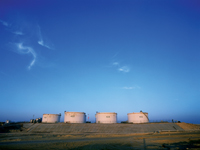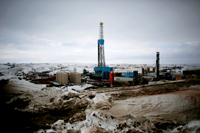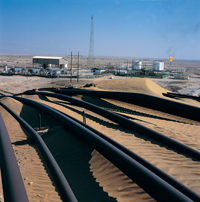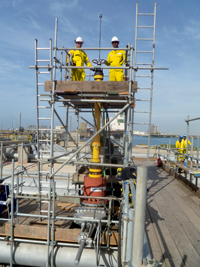
OMAN aims to produce just shy of 1 million barrels per day (mbpd) of crude oil in 2013 and expects output to hold steady over the next five years, a senior government official says, as the country also celebrated a major natural gas discovery.
Oil ministry undersecretary Nasser Al Jashmi says that the country would produce an average of 935,000 bpd this year and would remain at or above that level for the next 5-10 years. “Personally, I don’t believe there will be a decline after five years,” he says.
Oman expected to produce around 915,000 bpd in 2012.
Oman’s oil industry is dominated by PDO, a joint venture between the Omani government and several foreign oil companies led by Shell.
PDO says it has made a significant onshore gas discovery containing 2.9 trillion cubic feet (tcf) of gas and 115 million barrels of condensate in place.
“It’s a very significant discovery,” PDO’s managing director Raoul Restucci says.
The Mabrouk gas discovery, on the northern part of PDO’s concession, is a large field underlying a 60 sq km land area at a depth of up to 5,000 metres. The exploratory drilling took place last year, PDO says.
Although deep gas reservoirs in the Middle East and North Africa region are most often tight and sour, Mabrouk’s gas was sweet – largely free of the undesirable acid gases hydrogen sulphide and carbon dioxide – and the reservoir had good porosity, Restucci says.
The reservoir was conventional gas and would not require hydraulic fracturing to produce, Restucci says. “It’s probably going to be more than three years before we get to full field development, but it’s a tremendous discovery. It’s live,” he says.
Exploration wells completed in 2012 that struck the gas below central Oman’s previously developed Mabrouk heavy oil field had each produced gas at rates exceeding 80 million cubic feet per day (mmcfd), he adds.
An initial development-drilling phase for the gas reservoir could comprise 8-12 additional wells, with a second phase likely to follow, Restucci says.
“The scale of the find at Mabrouk is tremendous news for Oman as it will enable a further significant boost to economic growth and social development,” he says in a PDO statement.
PDO says it had also made five new all discoveries in 2012. Restucci says all of these were “small” and were contributing a combined 12,000 bpd to output to the joint venture’s 2012 oil production of about 550,000 bpd.
In a presentation, Restucci says PDO produced a record 1.24 million barrels of oil equivalent/d of oil and gas in 2012, surpassing the company’s previous record set in 2001.
He also says that PDO had brought its Amal steam and solar-assisted heavy oil project on stream in the week starting March 11.
The onshore oil development is expected to achieve peak production of 18,000-20,000 bpd.
PDO says its current output stood at 566,305 bpd of oil including 92,500 bpd of condensate, and 582,500 boepd of gas. Oil production was above the company’s plateau target for the next 10 years of maintaining output of at least 550,000 bpd.
The company says 2012 was the fifth successive year in which it had increased aggregate oil and gas production.
The joint venture planned to spend more than $800 million on exploration and development in Oman over the next five years, Restucci says.
“PDO accounts for around 70 per cent of the country’s crude oil production and nearly all of its gas supply so there is a huge onus on us to find and develop new fields of a challenging or ‘unconventional’ nature to replace those that are declining,” he says.
PDO in 2009 brought onstream the first phase of a an 80-well development project at the Mabrouk oil field, which was discovered in 1979, aimed at roughly doubling crude output to between 15,000 and 20,000 bpd along with 1-2 million cubic metres per day (35,000 to 75,000 mmcfd) of associated gas.
The company was planning to drill 100 wells over the next five years, Restucci says.
PDO says it would launch 16 significant new projects, many involving enhanced oil recovery, targeting the development of over 1 billion barrels of new oil reserves in aggregate. The program would require over $11 billion of investment, it estimated.
Gas development is another priority for Oman, which currently imports supplies from Qatar to offset LNG exported to Asian customers under long-term contracts. Those exports began before industrial development and population growth in the sultanate drastically increased domestic gas demand.
During a related presentation, Oman LNG CEO Harib Al Kitani says the LNG producer would close its operations in 2024, upon the expiration of its last remaining long-term contracts. It was not renewing contracts that expired
before then.



























































































